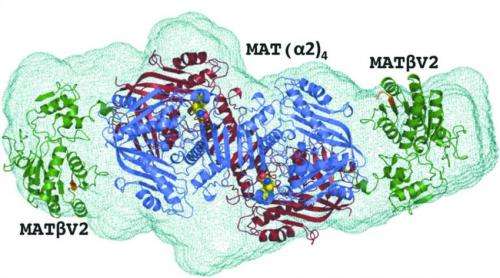A possible pathway for inhibiting liver and colon cancer is found

A group of scientists from Spain, the UK and the United States has revealed the structure of a protein complex involved in liver and colon cancers. Both of these types of cancer are of significant social and clinical relevance as in 2012 alone, liver cancer was responsible for the second highest mortality rate worldwide, with colon cancer appearing third in the list.
The international team from CIC bioGUNE, the University of Liverpool and the US research centre USC-UCLA has successfully unravelled the mechanism by which two proteins, MATα2 and MATβ, bind to each other, thereby promoting the reproduction of tumour cells in liver and colon cancers. The study was published in the latest issue of the open access journal IUCrJ published by the International Union of Crystallography.
This structural data discovery opens up additional research opportunities into drugs that can act on the binding of these proteins, thereby possibly inhibiting cancer cell growth.
As a result of this discovery, it is now known which part of their respective structures can be blocked to prevent these proteins from joining together. This is very important as when these proteins bind to each other, the production of a molecule known as SAMe, which plays a role in uncontrolled tumour cell growth, increases considerably. Though the relationship between SAMe and tumour growth has been known for some time, this molecule also has other important functions inside the cell that cannot be altered and there is currently no way of acting against it without affecting these other life-sustaining functions.
The good news is that MATα2 and MATβ are only overexpressed in adults with tumours therefore representing an excellent therapeutic target which could open the door to the creation of highly targeted drugs that act exclusively by blocking those regions that allow their mutual binding rather than attacking other regions of the body.
The CIC bioGUNE researcher Adriana Rojas, who led this study, mentioned during interview "Many years have passed since it was first understood which proteins produce SAMe and how the levels of this molecule affect cancer cell growth, and we have now shown that the complex between MATα2 and MATβ is a possible therapeutic target".
The research involved X-ray crystallography and solution X-ray scattering techniques utilizing some of Europe's most powerful X-ray synchrotron sources, ALBA in Spain and SOLEIL and DIAMOND in the UK.
More information: Murray et al. (2014). IUCrJ 1, 240-249; DOI: 10.1107/S2052252514012585
















